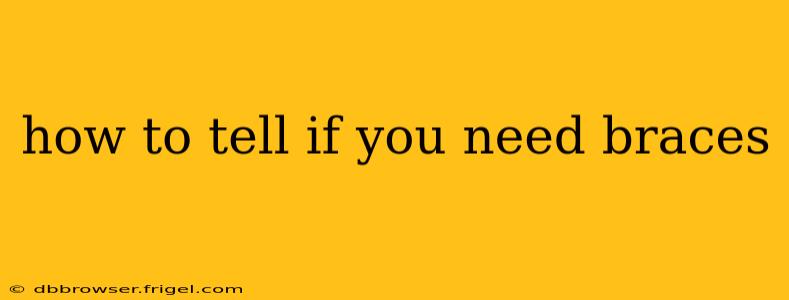Considering braces? It's a big decision, impacting both your smile and your confidence. Knowing when braces are necessary requires understanding the various signs and consulting a dental professional. This guide will help you determine if you need braces and what to expect during the process.
What are the Signs You Might Need Braces?
Several indicators suggest you might benefit from orthodontic treatment. These range from purely cosmetic concerns to more serious dental health issues. Let's explore them:
1. Crooked or Crowded Teeth: This is perhaps the most obvious sign. If your teeth are overlapping, rotated, or generally misaligned, braces can help straighten them. This improves aesthetics and makes teeth easier to clean.
2. Overbite or Underbite: An overbite occurs when your upper teeth significantly overlap your lower teeth. An underbite is the opposite, where your lower teeth extend beyond your upper teeth. Both can affect your bite and jaw alignment, potentially leading to jaw pain or temporomandibular joint (TMJ) disorders.
3. Crossbite: A crossbite happens when some of your upper teeth bite inside your lower teeth, instead of the usual outside alignment. This can impact your bite and jaw development.
4. Gaps Between Teeth (Diastema): While some find gaps charming, significant spacing can make it harder to clean teeth and may lead to gum disease. Braces can close these gaps for improved oral hygiene and aesthetics.
5. Difficulty Chewing or Biting: If you consistently struggle to bite or chew food effectively due to misaligned teeth, it might indicate a need for orthodontic correction.
6. Jaw Pain or TMJ Disorders: Misaligned teeth can contribute to temporomandibular joint (TMJ) disorders, causing pain in the jaw joint. Braces can sometimes alleviate this pain by improving the alignment of the bite.
7. Speech Impediments: In some cases, severely misaligned teeth can affect speech clarity. Orthodontic treatment can correct the alignment and improve speech.
8. Increased Risk of Gum Disease: Crowded or misaligned teeth can make it more difficult to maintain proper oral hygiene, increasing the risk of gum disease (gingivitis and periodontitis). Braces can facilitate better cleaning and reduce this risk.
How Do I Know for Sure if I Need Braces?
While this guide highlights common signs, only a qualified orthodontist or dentist can definitively diagnose the need for braces. A thorough examination is crucial. They will assess your teeth, bite, and jaw alignment to create a personalized treatment plan.
What Happens During a Consultation?
During your consultation, expect:
- A detailed examination: The dentist will examine your teeth, gums, and jaw to identify any issues.
- X-rays and photographs: These help the orthodontist to assess the underlying structure of your teeth and jaw.
- Discussion of treatment options: Based on your needs, the orthodontist will discuss various options, including braces, Invisalign, or other appliances.
- Cost and timeline discussion: You’ll receive an estimate of the total cost and the expected duration of treatment.
Are there Alternatives to Braces?
Yes, there are alternatives depending on the severity of the misalignment. These include:
- Invisalign: Clear aligners that gradually straighten teeth.
- Retainers: Used to maintain the position of teeth after braces or other orthodontic treatments.
In Conclusion:
If you have concerns about your teeth or bite, scheduling a consultation with an orthodontist is the best way to determine whether braces or another orthodontic treatment are right for you. Don't hesitate to seek professional advice; a healthy and beautiful smile is worth the investment!
